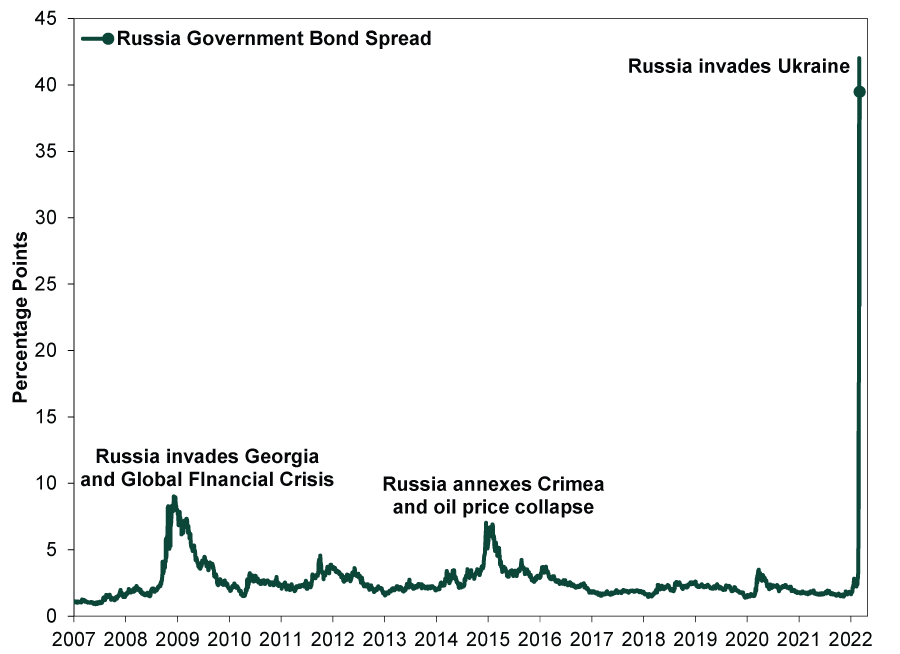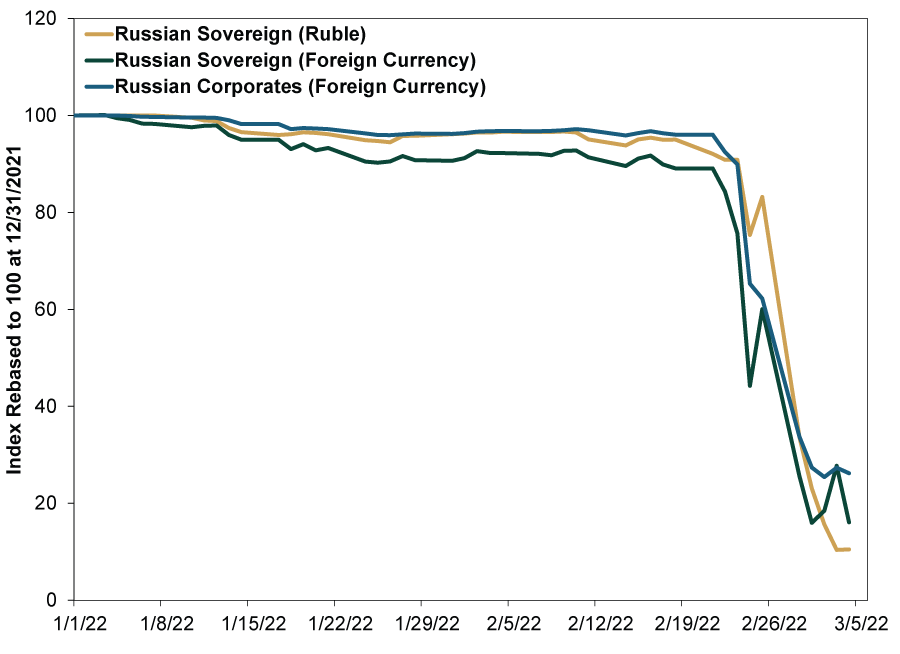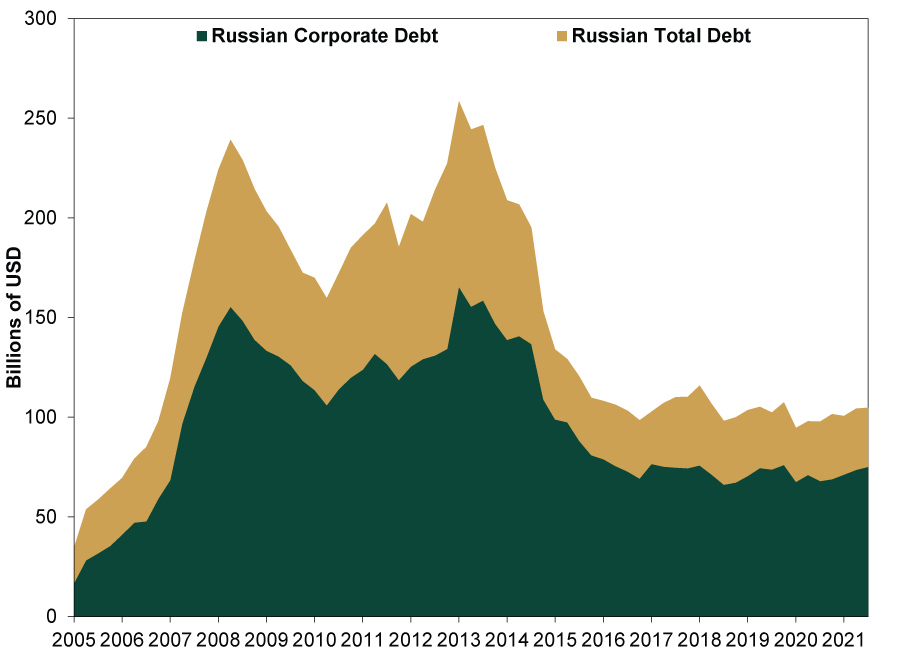Personal Wealth Management / Market Analysis
Russian Default’s Limited Financial Fallout
Some form of Russian sovereign bond default is looking rather likely, but the implications seem considerably smaller than 1998’s, which played a central role in that year’s correction.
All eyes continue to track the horrific war in Ukraine this week. But a related factor is also gaining prominence: Chatter over a Russian sovereign bond default is rising after the country failed to complete an interest payment to foreign holders of Russian bonds last Wednesday. The miss starts the clock ticking on a 30-day grace period. If that expires and bondholders don’t receive their money, it will be in technical default. Although this prospect seems to be stirring some fears—and memories of 1998’s Russian default, part of a larger Emerging Markets (EM) debt crisis—we don’t think a chain reaction is likely to stem from this.
Interestingly, Russia’s debt service failure initially appeared to be mutual. While Russia’s Ministry of Finance sent coupon payments to foreign holders of ruble-denominated sovereign debt, known as OFZs, the Central Bank of Russia (CBR) halted Russia’s National Settlement Depository from making payments to foreign clients.[i] Russian “President” Vladimir Putin overruled this policy on Monday, stating that he would permit the payments to go through—even to creditors in nations he considers hostile.[ii] However, another issue remains: Western clearing systems used to settle these payments stopped accepting them due to sanctions.
While such a default is unusual—Russia has plenty of rubles in its coffers to pay if allowed—it doesn’t change the effect on bondholders. Foreign investors in Russian OFZs could face substantial losses, if not complete write-offs—on top of the huge ruble depreciation they have already felt. The same fate could await foreign holders of dollar- and euro-denominated Russian debt, too. Payments on such bonds are scheduled for March 16, and markets reflect a high likelihood they will go unpaid.
Exhibit 1: Markets Have Priced Russian Default
Source: FactSet, as of 3/7/2022. JP Morgan EMBI Global Russia Index, 1/1/2007 – 3/4/2022.
The fallout from potential Russian default looks limited. At 2021’s end, foreigners held only $20 billion in foreign currency (mostly dollar and euro) sovereign debt and $41 billion in ruble debt—now hugely depreciated.[iii] For comparison, the US Treasury sold $50 billion in debt last month alone and plans to auction $48 billion more this month.[iv] Global sovereign debt and currency markets trade in the trillions daily. Russian exposure, while not nothing, is a drop in the bucket.
Foreign exposure to Russian corporate debt is a bit bigger, at around $75 billion as of last September.[v] But debt here looks more serviceable. Most of it was issued outside of Russia, and Russian corporations have dollar and euro bank deposits abroad to fund debt payments. They have the ability to pay. The question is whether they will be allowed to. It remains a gray area. But Russian foreign currency corporate bonds are already selling at steep discounts—around 30 cents on the dollar.[vi] The risk of non-payment looks to be priced in to a very great extent.
Exhibit 2: Russian Debt Selling at Steep Discounts
Source: FactSet, as of 3/7/2022. JP Morgan EMBI Global Russia Indexes (local and foreign currency) and JP Morgan Corporate EMBI Russia Index total returns, 12/31/2021 – 3/4/2022.
The lack of surprise at this point is a big reason we doubt there are any noteworthy contagion effects from Russian default. After all, sanctions stemming from its 2014 annexation of Crimea—and, apparently, in preparation for its invasion of Ukraine—mitigated the global effect.
Exhibit 3: Foreign Banks Reduced Exposure to Russian Debt
Source: BIS, as of 3/7/2022. Foreign bank ownership of Russian debt securities (corporate and total), Q1 2005 – Q3 2021.
As for the rest of EM debt markets, their past vulnerabilities were mostly related to servicing foreign currency debt while maintaining fixed exchange rates they couldn’t defend. Today is light years different. Currency pegs are almost entirely gone now, and most issuing EM countries (as Russia was formerly)[vii] have amassed large reserves to back their debt. Besides, the causal factors underpinning Russia’s default risk rising—starting a brutal war that is driving financial market restrictions—doesn’t apply to any nation other than Russia and Belarus.
Russia obviously has a big geopolitical footprint. However, its economy—and financial system—is far smaller and not critical to global markets, energy aside. Even if Russia doesn’t default, Putin’s decision to invade Ukraine is virtually assured to make Russia’s economic role far, far smaller for many years to come.
Hat Tip: Research Analysts Scott O’Leary, Delo Baker and Ori Powers
[i] “Russia Likely to Miss Interest Payment for First Time Since 1998 Crisis,” Anna Hirtenstein and Caitlin Ostroff, The Wall Street Journal, 3/3/2022.
[ii] “Putin’s Ruble Workaround Still Leaves Bond Payments in Doubt,” Irene Garcia Perez, Bloomberg, 3/6/2022.
[iii] “Investors Struggle to Trade Russian Assets as Sanctions Hit Market Plumbing,” Philip Stafford and Tommy Stubbington, Financial Times, 3/1/2022.
[iv] “Treasury Announces Details of Auctions of 3-Year, 10-Year Notes & 30-Year Bonds,” Staff, RTTNews, 3/3/2022.
[v] Source: BIS, as of 9/30/2021.
[vi] “Analysis: Ukraine War Raises Spectre of Russia's First External Debt Default,” Karin Strohecker, Reuters, 3/2/2022.
[vii] MSCI reclassified Russia from EM to standalone markets status last Wednesday after deeming it uninvestable. “From Crisis to Crisis: Russia’s Diminished Role in Emerging Markets,” Peter Zangari, MSCI, 3/3/2022.
If you would like to contact the editors responsible for this article, please message MarketMinder directly.
*The content contained in this article represents only the opinions and viewpoints of the Fisher Investments editorial staff.
Get a weekly roundup of our market insights
Sign up for our weekly e-mail newsletter.

You Imagine Your Future. We Help You Get There.
Are you ready to start your journey to a better financial future?

Where Might the Market Go Next?
Confidently tackle the market’s ups and downs with independent research and analysis that tells you where we think stocks are headed—and why.








